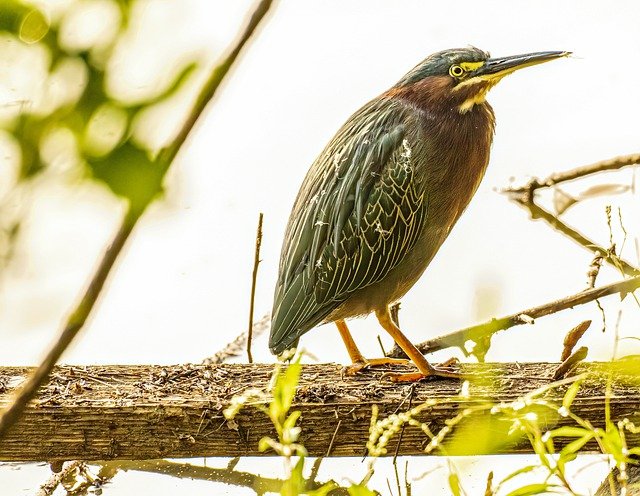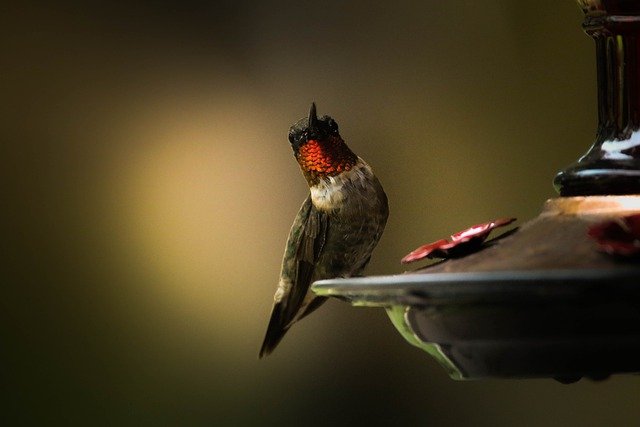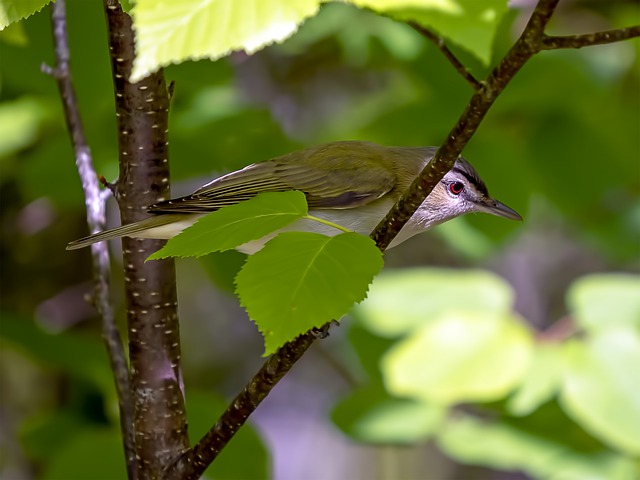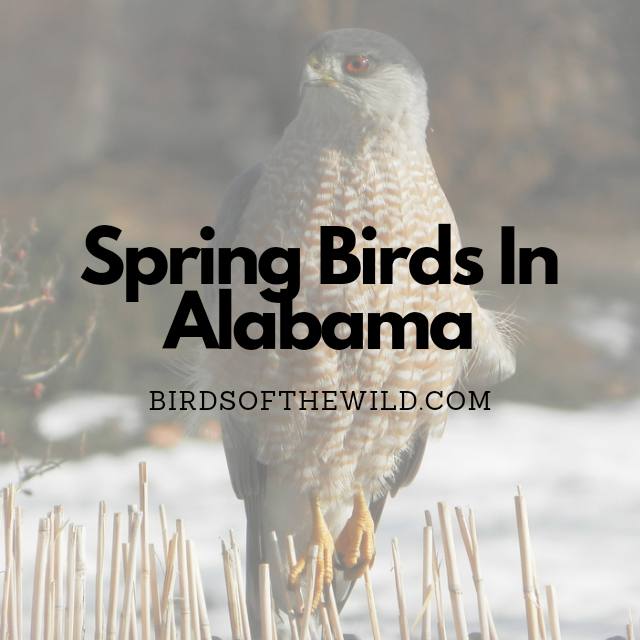Alabama is home to a large variety of birds, from hawks, migratory birds like hummingbirds, finches and many many more, especially found throughout spring. In this article I’ll be covering the 9 birds that can be spotted in the state within the months of spring so, continue reading to learn more about them below.
- American Kestrel
- Cooper’s Hawk
- Red Shouldered Hawk
- Eastern Screech Owl
- Great Horned Owl
- Green Heron
- Ruby Throated Hummingbird
- Red Eyed Vireo
- Northern Cardinal
9 Spring Birds In Alabama
1. American Kestrel (Falco Sparverius)

- Size: 20 – 24cm
- Weight: 115 – 125 grams
- Wingspan: 50 – 60cm
You’ll find American kestrels in all of Alabama on a year round basis which includes the spring months.
American kestrels are recognised by their spotted orange, gray, black and white plumage with their back orange with a black horizontal pattern, their wings a gray color, black tail feathers and orange sides with a gray and white head that has 2 black lines drawn vertically near both eyes. Females are mostly light brown.
American kestrels can be found in a variety of open or semi-open habitats from forest clearings, farmland and deserts.
As for what they eat, it includes small mammals such as woodmice and shrews, small birds, insects, earthworms with voles being their go to food source.
Wild American kestrels are known to live for around 5 years but, captive variants have been known to hit 17+ years.
2. Cooper’s Hawk (Accipiter Cooperii)

- Size: 35 – 51cm
- Weight: 400 – 700 grams
- Wingspan: 73 – 94cm
You’ll find cooper’s hawks throughout the majority of Alabama throughout the year which would include the spring months.
Cooper’s hawks are recognised by their gray back and upper head with a orange and white patterned breast, legs and underside of the wing. The females and males look very much the same but, the females are around 30% larger than the opposite gender.
You’ll often find a cooper’s hawk around pines, oaks, Douglas-firs, beeches, spruces, and other tree species, often on flat ground rather than hillsides, and in dense woods.
As for what they eat, it includes mainly medium-sized birds including robins, jays, flickers, among other smaller and even larger birds. Small mammals like chipmunks, tree squirrels, ground squirrels, mice, bats, etc. are included in their diet too.
Cooper’s hawks tend to live for around 10 – 12 years on average whilst the oldest recorded hawk surpassed the 20 year mark.
3. Red Shouldered Hawk (Buteo Lineatus)

- Size: 38 – 48cm
- Weight: 540 – 720 grams
- Wingspan: 94 – 107cm
These red shouldered hawks are year round residents within all of Alabama, which would include the spring months.
Red shouldered hawks are recognised by their orange colored breasts, face and neck, red coloured shoulders, their patterned dark brown white wings and tail feathers. Both males and females look the same but, the females are the larger of the 2 by around 25 – 30%
These hawks can be spotted around mixed deciduous coniferous forests with open understories. They particularly prefer wet forests, especially bottomlands near streams, rivers, swamps, and marshes.
Red shouldered hawks are birds of prey and in turn will often consume amphibians, reptiles, birds, mammals and crayfish.
The average red shouldered hawk would live around 15 – 19 years whilst captive ones have been known to live for around 26 years.
4. Eastern Screech Owl (Megascops Asio)

- Size: 16 – 25cm
- Weight: 121 – 244 grams
- Wingspan: 49 – 61cm
You’ll spot eastern screech owls all throughout Alabama on a year round basis, which would include spring.
Eastern screech owls are recognised by their mostly gray plumage. Females are generally larger and have a feathers that are brown in color.
These owls can be found around open mixed woodlands, deciduous forests, parklands, wooded suburban areas, riparian woods along streams and wetlands.
Eastern screech owls eat a variety of foods from small animals, including birds and mammals as well as earthworms, insects, crayfish, tadpoles, frogs, and lizards.
As for how long these owls are known to live for, it’s typically around the 14 year mark in the wild.
5. Great Horned Owl (Bubo Vrginianus)

- Size: 57 – 63cm
- Weight: 1.4 – 1.5kg
- Wingspan: 1.35 – 1.5m
Great horned owls can be found all across Alabama from spring till winter.
These large horned owls are recognised by their brown/gray plumage with their defining feature being the tuft of feather on the top of their head resembling a horn or ear like feature. Male and female great horned owls look relatively the same with the females slightly larger in size.
At night these birds will perch on a branch or a tall building to look around for prey and once the desired prey has been found they will fly towards it with folded wings, grab the prey with their talons piercing through their body and in most cases killing them immediately.
As for what these birds eat it includes smaller prey like rodents, frogs or scorpions. Even other larger predators like geese, ducks, hawks, and smaller owls can be eaten by these carnivorous birds.
Great horned owls are most commonly found in deserts, wetlands, forests, grasslands, backyards, cities and they can also be found in semi-open habitats between the Arctic and the tropics.
As for a great horned owls lifespan, it can be anywhere from 15 -25 years.
6. Green Heron (Butorides Virescens)

- Size: 40 – 44cm
- Weight: 230 – 250 grams
- Wingspan: 54 – 58cm
Green herons can be found in Alabama when they’re breeding. This will mostly include the spring and summer months.
These heron’s are recognised by their darker green back and wings, maroon chest and neck, with yellow legs and a relatively long and pointy black beak. Females on the other hand are mostly brown and gray in color.
Green herons tend to spend the majority of their time around wetlands like lakes, ponds, marshes, swamps, streamsides and rivers.
As for what they consume, it includes a variety of different sources such as small fish like minnows, sunfishes, gizzard shads, crustaceans, aquatic insects, frogs, tadpoles, grasshoppers, snakes, earthworms, snails and other smaller rodents.
Green herons don’t have the longest of lifespans for a bird of their size, with the maximum known life expectancy said to be around 8 years.
7. Ruby Throated Hummingbird (Archilochus Colubris)

- Size: 7 – 9cm
- Weight: 2 – 6 grams
- Wingspan: 8 – 11cm
Ruby throated hummingbirds can be found in Alabama when breeding. This will generally include the spring along with the summer months.
A ruby throated hummingbird can be recognised by their plumage that is red, white and green. Their throat is the red part, its breast/stomach white in color and their wings and back an emerald green color. Females are mostly white and green in color.
As for what they eat, it ranges from small insects, fruits, sugar water from feeders, tree sap and of course the nectar produced by blooming flowers.
Ruby throated hummingbirds tend to stay near environments with flowerbeds as these birds have a very strong metabolism that requires them to feed multiple times per hour. Therefore, you can find them in fields, parks, backyards, and open clearings in forests.
As for how long these tiny little hummingbirds can live for, it’s known to be around 3 – 5 years on average with the longest recorded lifespan just short of 7 years.
8. Red Eyed Vireo (Vireo Olivaceus)

- Size: 11 – 13cm
- Weight: 20 – 24 grams
- Wingspan: 23 – 25cm
Red eyed vireos can be found in Alabama when they happen to go through their breeding season. The normal time frame for this would be around the spring and summer like most other avian lifeforms.
These vireos are recognised by there green feathers from head, wings and back, white feathers on their breast and the stand out red eye. The females look very similar to the males.
As for where you’ll often see these birds perching or flying around, it would include environments with large expanses of deciduous forest, particularly deciduous trees with large leaves, like maple trees for example.
Red eyed vireos tend to eat mostly insects like caterpillars, moths, beetles, wasps, bees, ants, bugs, flies, as well as the occasional fruit and berry.
Red eyed vireos tend to live for around 6 – 7 years, whilst the oldest recorded one died at 10 years and 2 months.
9. Northern Cardinal (Cardinalis Cardinalis)

- Size: 21 – 23cm
- Weight: 42 – 48 grams
- Wingspan: 30 – 35cm
Northern cardinals are permanent residents of Alabama so, there is a good chance of you spotting them in the state throughout spring too.
These cardinals are recognised by their mohawk like head feathers, red exterior and beak with elements of black across the face. Females also have elements of red on their beaks and their body but at smaller amounts with the majority of their plumage being a light brown color.
These cardinals can be found in woodlands, gardens, shrublands, wetlands and can even be brought into your backyard if you have sugar water or seeds that satisfy their taste buds.
As for the food they eat, it consists of small insects like beetles, true bugs, grasshoppers, caterpillars, ants, flies, spiders, centipedes, and snails. Seeds of weeds, berries among other smaller fruits are other food sources that consume also
Northern cardinals are known to live for around 15 years in the wild although the actual number is far less grand.
Amhil Khan, a dedicated nature enthusiast and the founder of BirdsOfTheWild.com, is a passionate advocate for the captivating world of avian wonders. With a deep-seated curiosity about the intricate lives of birds, Amhil’s journey began as a fascination and has evolved into a mission to inspire others to appreciate and protect these magnificent creatures.
Amhil’s love for birds led to the creation of Birds of the Wild, a platform where his expertise in ornithology, coupled with his captivating storytelling, provides readers with an immersive and educational experience. Through his lens and words, he captures the essence of birds in their natural habitats, offering a glimpse into their behaviors, migrations, and the ecosystems they inhabit.

